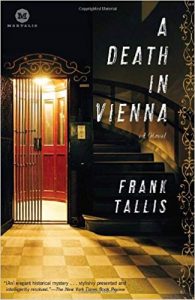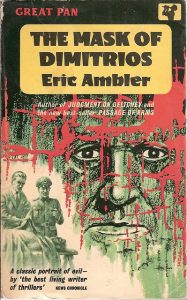Some years ago, I heard Toni Morrison interviewed on NPR about her latest novel, discussing her efforts to learn whether dandelions could grow on a particular plot of land in a particular city. She was writing fiction, but she had to know.
I pumped my fist—so pleased to hear this. It was a rebuke of sorts to people who say: Hey, it’s fiction, just make it up.
The murder mysteries and thrillers I like the best offer a vibrant sense of place and time. The fancy word for this is verisimilitude—the feeling of truth. This might sound easy, but to a writer it doesn’t come easily. It requires either a preternatural imagination or, for the mortals among us—and apparently even for Toni Morrison, the Nobelist—a ton of research.

Among my favorite murder mysteries is The Last Kashmiri Rose, by Barbara Cleverly, published in 2001. It is an old-fashioned, Agatha Christie-style mystery, in which everyone in turn is a suspect. The story is nicely structured, in that the ending (spoiler alert!) loops back to the beginning. But its finest feature is the setting—India in 1910 and 1922, during the declining days of the Raj. Cleverly is a British writer who found in her attic a trunk filled with memorabilia of a great uncle’s decades in colonial India. I don’t know how much time Cleverly herself spent in and around Calcutta, but the place and time are lovingly rendered. You can almost smell the saffron.
One thing I know for sure, though, is that Cleverly hadn’t spent a moment in Calcutta-circa-1922. Making the history come alive surely took research, both in her attic trunk and beyond.

Similarly for The Man from St. Petersburg, by Ken Follett, probably my favorite thriller. The story, set in 1914 London, follows an anarchist’s pursuit of a Russian diplomat he plans to assassinate to prevent a naval agreement from being signed. A young Winston Churchill strides through the plot with all the assurance of his later self. Follett is Welsh by birth and a Londoner by education, so evoking a city in which the past remains a badge of pride wasn’t the most daunting of tasks. But to portray the aristocratic habits (“The crockery used for servants’ meals was racked neatly in the dresser; the cook’s knives and spoons hung from a row of hooks…”) and the political circumstances of the day took painstaking research to get the details right.
That is, I assume the details are right. More precisely, I am given no reason to assume otherwise. This, of course, is the point of research—to get the details accurate, or at least plausible enough, to allow readers to suspend their disbelief. It is the accretion of details—not slathered on, but woven into the story—that lures the reader into another time and place.

A few examples. Frank Tallis’s series of mysteries set in turn-of-the-20th-century Vienna brings to life the city of Freud and Mahler. (From A Death in Vienna, his first one: “The public house—a gloomy cellar, illuminated by flickering gas lights and the red glow from a squat cast-iron stove—was situated in the working class suburb of Meidling.”) Or Caleb Carr’s The Alienist, with its lush and grisly descriptions of Manhattan in 1896, including of the city’s dashing police commissioner, one Theodore Roosevelt. Or that most daring and erudite of murder mysteries, The Name of the Rose, by Umberto Eco, set in an Italian monastery in 1327.
That Eco was an Italian and a world-class scholar gave him a leg up in his research. Immersion helps. This also goes for Alan Furst, the author of a series of atmospheric spy thrillers set in Europe between the world wars. Furst, a native of New York, spent years living in Paris, where several of his novels take place. But his stories also slink along the alleys of Prague, Berlin, Sofia, Moscow, and such, in creating a mood of mystery and intrigue. This took research.
How did these authors do their research? I haven’t a clue. All I know is how I did mine, in my two historical mysteries, The Murder of Willie Lincoln and The Attempted Murder of Teddy Roosevelt, both of them set mainly in Washington, D.C., in 1862 and 1902, respectively.
Immersion helped. I’ve worked in and around Washington for most of my professional life. The American capital, like England’s, glories in its history and tries to preserve it. I would sit in Lafayette Park late at night, across from the White House, trying to block out any mechanical noises and to imagine sitting there more than a century ago. While touring the city’s Old Soldiers’ Home, where President Lincoln spent summers, I slid my hand along the same staircase railing that he touched. It’s no exaggeration to say that I felt his presence.
Yet a tactile connection isn’t enough, on its own, to create verisimilitude. Details matter, too. I’m a journalist by trade, and I’ve written three books of nonfiction, so I’ve gone about the task of researching mysteries as if I were researching nonfiction. I’ve dived into archives, diaries, memoirs, personal papers, and books of every description, and visited the places I write about. Newspapers of the period offered evocative anecdotes. I look for small items on back pages about incidents too common for prominence: “An automobile horn blared, causing a nag to rear, tying up traffic.” I think these touches help to make a story—fiction or nonfiction—feel true.
Research can also help with the characters and plot. Learning that Lincoln’s White House was crammed with crooks and secret secessionists suggested suspects and lines of inquiry. Most of my characters are real, so researching them made it easier to write dialogue, which requires an understanding of what’s going on in their heads and hearts.
But historical research goes only so far. It provides the groundwork for a crime story, the background, the atmosphere, but not the gist of it. For that, there’s no substitute for imagination. Research is the soil in which the imagination takes root—and can flower.

Consider my single favorite crime-related fiction. The Mask of Dimitrios, published in 1939 by the British thriller writer Eric Ambler, is a murder mystery in a thriller’s guise. The protagonist, a writer of detective novels, sees the body of a criminal that washed up on a Bosporus beach and investigates the back story as he gallivants across Europe, from Istanbul to Smyrna to Athens to Sofia to Belgrade to Geneva and finally to Paris. Ambler based the criminal’s character on a real-life Greek arms dealer, and I have no doubt that he had visited every city where a scene takes place.
This doesn’t, however, explain the novel’s magic. Ambler’s imagination—or Umberto Eco’s or Toni Morrison’s—is what breathes life into these places and characters, in a way that keeps readers turning pages into the night. Readers want to feel like they’re there. That is the point of these stories, if they’re told right.


















